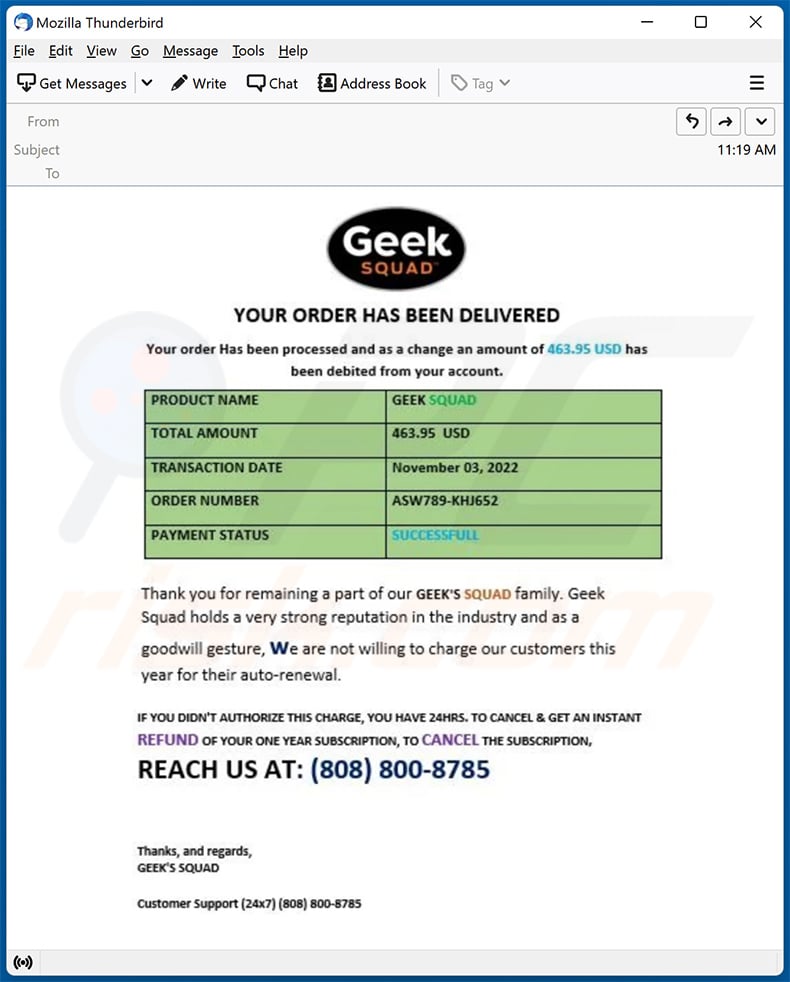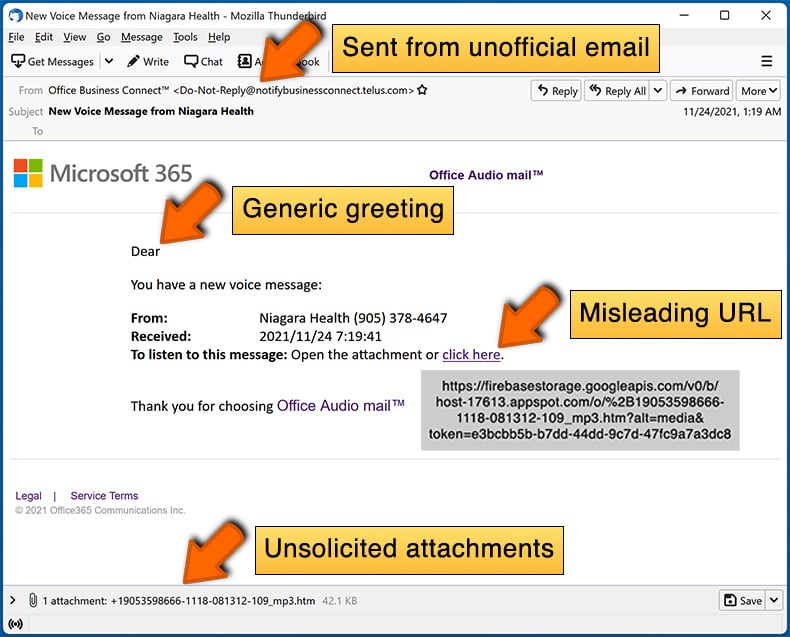How to spot scam emails used to trick recipients into installing ScreenConnect?
Phishing/ScamAlso Known As: ConnectWise remote control phishing
Get free scan and check if your device is infected.
Remove it nowTo use full-featured product, you have to purchase a license for Combo Cleaner. Seven days free trial available. Combo Cleaner is owned and operated by RCS LT, the parent company of PCRisk.com.
What is ScreenConnect (ConnectWise) Client scam?
Fraudsters use all kinds of ways to extract information or money from people and distribute malicious programs via emails. This article describes cases where fraudsters use emails to trick recipients into installing ConnectWise (formerly known as ScreenConnect).
This software allows threat actors to perform malicious activities on computers. The method of using legitimate remote access tools (such as TeamViewer, UltraViewer and similar) to control victim's computers is rather common among scammers, as it is easy to trick people into installing legitimate and recognizable software.

More about ScreenConnect (ConnectWise) client and how scammers misuse it
ConnectWise is legitimate software, an IT service management tool that allows users to control and access computers or servers. Fraudsters have been observed using emails to trick recipients into downloading and installing ConnectWise on their computers. Some scammers may use the name ScreenConnect instead of ConnectWise in their scams.
An example of the email used to trick users into installing ConnectWise is "Geek Squad Email Scam". These emails usually claim that a subscription has been renewed to trick recipients into calling the provided numbers. Once scammers are called, they instruct people to download and install ConnectWise.
Additionally, scammers behind these emails may be asking to provide personal information (e.g., credit card details or ID card information).
Once the ConnectWise software is installed on computers and the session is joined, crooks can start performing malicious activities. Usually, they try to obtain sensitive information or download malware (e.g., ransomware or crypto-mining malware) on computers. It is known that ConnectWise is or was used to distribute ZEPPELIN ransomware.
It is also possible that threat actors may use the ConnectWise (or ScreenConnect) software name to disguise their malware. They may distribute malware by disguising it as installers of the legitimate software.
| Name | ScreenConnect (ConnectWise) Client Scam |
| Threat Type | Phishing, Scam, Social Engineering, Fraud |
| Fake Claim | Subscribtion has been renewed |
| Disguise | Letter from Geek Squad or other legitimate company |
| Related Domains | adobe-express[.]com, authenticate-meta[.]com, canva-dreamlab[.]com, canvaproai[.]com, capcutproai[.]com, cavadreamlab[.]com, chromeupdates[.]com, klingdowai[.]com, klingdownload[.]com, openart-ai[.]com, renderforestai[.]com, vancadreamlab[.]com, xmetavn[.]com |
| Symptoms | Unauthorized online purchases, changed online account passwords, identity theft, illegal access of the computer. |
| Distribution methods | Deceptive emails and websites (e.g., technical support scam pages). |
| Damage | Loss of sensitive private information, monetary loss, identity theft. |
| Malware Removal (Windows) |
To eliminate possible malware infections, scan your computer with legitimate antivirus software. Our security researchers recommend using Combo Cleaner. Download Combo CleanerTo use full-featured product, you have to purchase a license for Combo Cleaner. 7 days free trial available. Combo Cleaner is owned and operated by RCS LT, the parent company of PCRisk.com. |
Other scams used to gain remote access to computers
Pop-up scams are also used to trick users into providing remote access to their computers. In these cases, scammers use deceptive websites claiming that a computer is infected or there is another problem that must be fixed immediately. Typically, these pages display fake virus warnings, error alerts, and other messages, and provide fake technical support numbers.
Examples of emails and websites used to trick users into calling scammers are "Norton Subscription Will Renew Today", "Norton Cloud Subscription Activated Email Scam", "Your Windows Got Corrupted Due To Virus POP-UP Scam", and "Pirated Windows Software Detected In This Computer POP-UP Scam".
Threat actors can also use emails to lure visitors into infecting computers without installing remote administration software.
How do spam campaigns infect computers?
Emails used to deliver malware contain malicious attachments or links. Threat actors behind them aim to lure recipients into opening malicious pages or files. In most cases, users infect computers via malicious MS Office, PDF documents, executables, JavaScript files, archives like ZIP or RAR, and ISO files.
It is worth mentioning that users infect computers via malicious MS Office documents by enabling macros commands (editing or content). MS Office 2010 and other versions released after include the "Protected View" mode that prevents malicious documents from infecting computers right after they are opened.
How to avoid installation of malware?
Download software (and files) from official web pages. Avoid downloads from P2P networks, third-party downloaders, shady websites, free file hosting sites, etc. Be careful with emails containing malicious links or attachments. Do not open their contents without being sure it is safe, especially when they are not relevant and sent from unknown addresses.
Use reputed antivirus software for computer protection and run system scans with it regularly. Keep the operating system and installed software updated. If you've already opened malicious attachments, we recommend running a scan with Combo Cleaner Antivirus for Windows to automatically eliminate infiltrated malware.
Cyber criminals have been recently promoting ScreenConnect software via fake AI video generating websites. The list includes a lot of sites, some of which are already shut down, but more are likely to come. Here are few examples:
Instant automatic malware removal:
Manual threat removal might be a lengthy and complicated process that requires advanced IT skills. Combo Cleaner is a professional automatic malware removal tool that is recommended to get rid of malware. Download it by clicking the button below:
DOWNLOAD Combo CleanerBy downloading any software listed on this website you agree to our Privacy Policy and Terms of Use. To use full-featured product, you have to purchase a license for Combo Cleaner. 7 days free trial available. Combo Cleaner is owned and operated by RCS LT, the parent company of PCRisk.com.
Quick menu:
- What is ConnectWise remote control phishing?
- Types of malicious emails.
- How to spot a malicious email?
- What to do if you fell for an email scam?
Types of malicious emails:
![]() Phishing Emails
Phishing Emails
Most commonly, cybercriminals use deceptive emails to trick Internet users into giving away their sensitive private information, for example, login information for various online services, email accounts, or online banking information.
Such attacks are called phishing. In a phishing attack, cybercriminals usually send an email message with some popular service logo (for example, Microsoft, DHL, Amazon, Netflix), create urgency (wrong shipping address, expired password, etc.), and place a link which they hope their potential victims will click on.
After clicking the link presented in such email message, victims are redirected to a fake website that looks identical or extremely similar to the original one. Victims are then asked to enter their password, credit card details, or some other information that gets stolen by cybercriminals.
![]() Emails with Malicious Attachments
Emails with Malicious Attachments
Another popular attack vector is email spam with malicious attachments that infect users' computers with malware. Malicious attachments usually carry trojans that are capable of stealing passwords, banking information, and other sensitive information.
In such attacks, cybercriminals' main goal is to trick their potential victims into opening an infected email attachment. To achieve this goal, email messages usually talk about recently received invoices, faxes, or voice messages.
If a potential victim falls for the lure and opens the attachment, their computers get infected, and cybercriminals can collect a lot of sensitive information.
While it's a more complicated method to steal personal information (spam filters and antivirus programs usually detect such attempts), if successful, cybercriminals can get a much wider array of data and can collect information for a long period of time.
![]() Sextortion Emails
Sextortion Emails
This is a type of phishing. In this case, users receive an email claiming that a cybercriminal could access the webcam of the potential victim and has a video recording of one's masturbation.
To get rid of the video, victims are asked to pay a ransom (usually using Bitcoin or another cryptocurrency). Nevertheless, all of these claims are false - users who receive such emails should ignore and delete them.
How to spot a malicious email?
While cyber criminals try to make their lure emails look trustworthy, here are some things that you should look for when trying to spot a phishing email:
- Check the sender's ("from") email address: Hover your mouse over the "from" address and check if it's legitimate. For example, if you received an email from Microsoft, be sure to check if the email address is @microsoft.com and not something suspicious like @m1crosoft.com, @microsfot.com, @account-security-noreply.com, etc.
- Check for generic greetings: If the greeting in the email is "Dear user", "Dear @youremail.com", "Dear valued customer", this should raise suspiciousness. Most commonly, companies call you by your name. Lack of this information could signal a phishing attempt.
- Check the links in the email: Hover your mouse over the link presented in the email, if the link that appears seems suspicious, don't click it. For example, if you received an email from Microsoft and the link in the email shows that it will go to firebasestorage.googleapis.com/v0... you shouldn't trust it. It's best not to click any links in the emails but to visit the company website that sent you the email in the first place.
- Don't blindly trust email attachments: Most commonly, legitimate companies will ask you to log in to their website and to view any documents there; if you received an email with an attachment, it's a good idea to scan it with an antivirus application. Infected email attachments are a common attack vector used by cybercriminals.
To minimise the risk of opening phishing and malicious emails we recommend using Combo Cleaner Antivirus for Windows.
Example of a spam email:

What to do if you fell for an email scam?
- If you clicked on a link in a phishing email and entered your password - be sure to change your password as soon as possible. Usually, cybercriminals collect stolen credentials and then sell them to other groups that use them for malicious purposes. If you change your password in a timely manner, there's a chance that criminals won't have enough time to do any damage.
- If you entered your credit card information - contact your bank as soon as possible and explain the situation. There's a good chance that you will need to cancel your compromised credit card and get a new one.
- If you see any signs of identity theft - you should immediately contact the Federal Trade Commission. This institution will collect information about your situation and create a personal recovery plan.
- If you opened a malicious attachment - your computer is probably infected, you should scan it with a reputable antivirus application. For this purpose, we recommend using Combo Cleaner Antivirus for Windows.
- Help other Internet users - report phishing emails to Anti-Phishing Working Group, FBI’s Internet Crime Complaint Center, National Fraud Information Center and U.S. Department of Justice.
Frequently Asked Questions (FAQ)
Why did I receive this email?
Scammers sent the same letter to all recipients. Usually, emails of this kind are not personal (they are non-targeted).
What is the purpose of this scam?
Scammers use such emails and deceptive pages to trick recipients into calling them and installing remote administration software on their computers.
What can scammers do while having remote access to my computer?
They can obtain sensitive information, hijack online accounts, make fraudulent purchases, infect computers with malware, delete files, and perform other malicious activities.
Will Combo Cleaner remove malware infections?
Yes, Combo Cleaner can detect and eliminate almost all known malware. A full system scan should be performed in order to detect (and remove) high-end malware. Usually, malware of this kind hides deep in the operating system.
Share:

Tomas Meskauskas
Expert security researcher, professional malware analyst
I am passionate about computer security and technology. I have an experience of over 10 years working in various companies related to computer technical issue solving and Internet security. I have been working as an author and editor for pcrisk.com since 2010. Follow me on Twitter and LinkedIn to stay informed about the latest online security threats.
PCrisk security portal is brought by a company RCS LT.
Joined forces of security researchers help educate computer users about the latest online security threats. More information about the company RCS LT.
Our malware removal guides are free. However, if you want to support us you can send us a donation.
DonatePCrisk security portal is brought by a company RCS LT.
Joined forces of security researchers help educate computer users about the latest online security threats. More information about the company RCS LT.
Our malware removal guides are free. However, if you want to support us you can send us a donation.
Donate




▼ Show Discussion